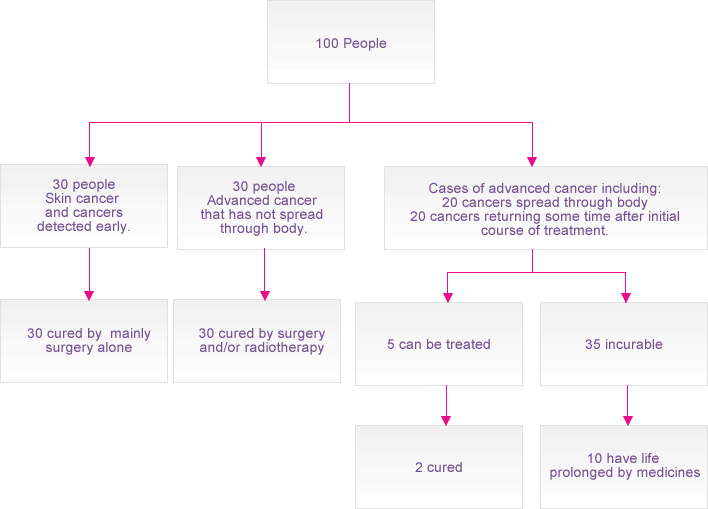This topic takes on average 25 minutes to read.
There are a number of interactive features in this resource:
 Chemistry
Chemistry
 Biology
Biology
 Human biology
Human biology
 PSHE / Citizenship studies
PSHE / Citizenship studies
Prevention is better than cure. Avoiding things like an unhealthy diet, lack of exercise, smoking and excessive exposure to sunlight can help reduce the risk of developing cancer. Early detection can also help to catch tumours before they have spread.
Cancer can start anywhere in the body and it can spread to form secondary tumours. Doctors need to be able to tackle the primary tumour as well as any secondary tumours. Often a range of medicines and treatments are used together.
Researchers continue to develop better methods for detecting and treating cancer. The effects of this research and development can be seen in the graph. It shows the increase in people who are surviving for 10 years or more after their cancer was detected.

There is never likely to be one single treatment that can be used against all the different types of cancer. However, researchers are constantly looking for improved treatments that kill cancer cells without being harmful to normal body cells.
| Viruses | Viruses normally infect cells where they reproduce and destroy the cell. This usually causes problems but some viruses are being genetically modified so that they will only infect cancer cells. The virus only kills cancer cells and leaves normal cells unharmed. |
| Stem cells | Stem cells can be used to replace cells that produce red blood cells, white blood cells and platelets in the bone marrow. This is useful if the bone marrow has been damaged due to radiotherapy or chemotherapy. New research suggests that certain stem cells could also be used to target the destruction of cancer cells. |
| Gene therapy | Gene therapy involves getting a section of DNA into a patient's cells. Some researchers are looking at how gene therapy could be used to treat cancer. If a cancer is caused by a faulty gene, then a 'healthy' gene could be inserted into the patient's cells. Other approaches target the immune system to help it fight the cancer cells more effectively. Some treatments are looking at using gene therapy to make cancer cells more sensitive to chemotherapy or radiotherapy. |
| Personalised medicine | Personalised (sometimes called stratified) medicine is already being used for some types of cancer. An example is seen in the treatment of a type of lung cancer. Patients can be screened to see if they have a particular genetic mutation. If they do, doctors know that they are likely to respond well to a medicine called gefitinib (Iressa ©). Knowing this helps to personalise the treatment to be as effective as possible. In the future advances in DNA-sequencing technology may allow doctors to quickly analyse a patient's genetic make-up and see which therapy they will respond to. This will allow doctors to tailor the types of medicines used and so reduce unwanted side effects. |
A virus, called HPV, is linked with the development of cervical cancer. Vaccines have been developed against this virus. In the UK, vaccination against HPV is made available for girls aged 12-13. Researchers are investigating a range of microbes that may have links with cancer. These include hepatitis B and C viruses with liver cancer and the bacteria Helicobacter pylori with stomach cancer. Developing further vaccines may allow people to be immunised against microbes linked with cancer.
Look at picture below. It looks at a 'typical' 100 cases of people who have been diagnosed as having cancer and summarises the treatments and survival rates.
